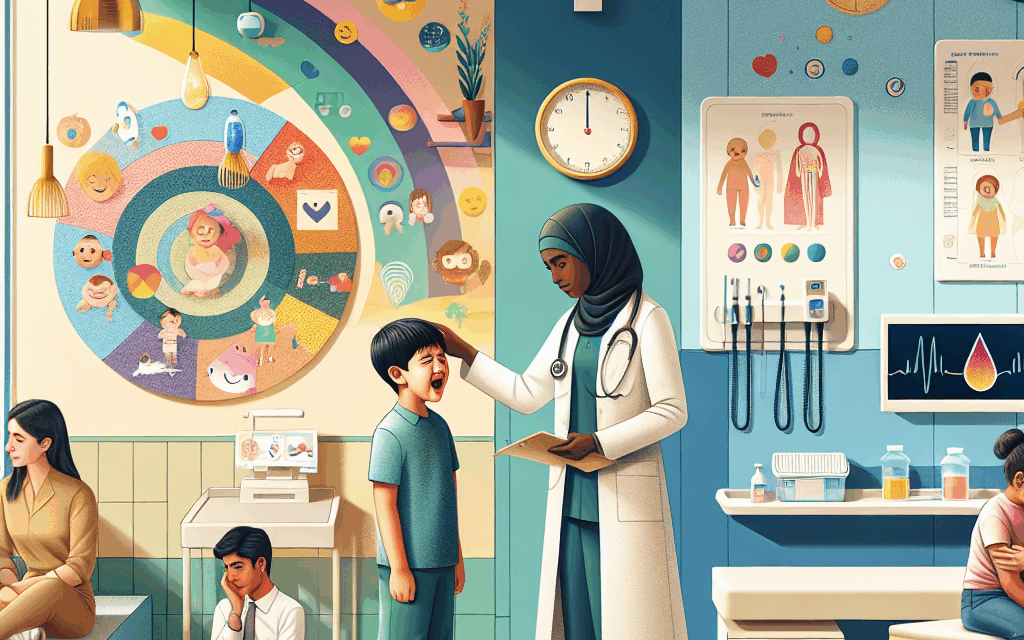Finding Serenity: The Role of Pediatric Healthcare Design in Enhancing Emotional Wellbeing
In the realm of healthcare, the design of pediatric facilities plays a crucial role in shaping the experiences of young patients and their families. The emotional wellbeing of children undergoing medical treatment is significantly influenced by their environment. This article explores the multifaceted relationship between pediatric healthcare design and emotional wellbeing, highlighting how thoughtful design can foster serenity and support healing. We will delve into five key areas: the importance of environment, the impact of color and light, the role of nature, the significance of play and interaction, and the integration of family spaces.
The Importance of Environment
The physical environment of a pediatric healthcare facility can either alleviate or exacerbate the stress associated with medical treatment. Research indicates that children are particularly sensitive to their surroundings, and a well-designed space can promote a sense of safety and comfort. The concept of “healing environments” has gained traction in recent years, emphasizing the need for spaces that support both physical and emotional healing.
One of the primary considerations in pediatric healthcare design is the reduction of anxiety. Children often experience fear and uncertainty when visiting hospitals or clinics. A study published in the journal “Health Environments Research & Design” found that children who were treated in environments designed with their needs in mind reported lower levels of anxiety compared to those in traditional healthcare settings. Key elements that contribute to a calming environment include:
- Welcoming entrances and waiting areas
- Child-friendly furniture and decor
- Clear signage and wayfinding
- Private spaces for consultations and treatments
For instance, the Children’s Hospital of Philadelphia has implemented a design that prioritizes the emotional wellbeing of its young patients. The hospital features bright colors, interactive art installations, and comfortable waiting areas that encourage play and exploration. This thoughtful approach not only distracts children from their medical concerns but also fosters a sense of belonging and community.
Moreover, the layout of pediatric facilities should facilitate easy navigation for both children and their families. Confusing layouts can lead to increased stress and anxiety. By incorporating intuitive wayfinding systems, such as colorful pathways or themed areas, healthcare designers can help children feel more in control of their environment. This sense of agency is crucial for emotional wellbeing, as it empowers children to engage with their surroundings positively.
The Impact of Color and Light
Color and light are powerful tools in pediatric healthcare design, influencing mood, behavior, and overall emotional wellbeing. Research has shown that specific colors can evoke different emotional responses. For example, warm colors like yellow and orange can create feelings of happiness and energy, while cooler colors like blue and green can promote calmness and relaxation.
In pediatric settings, designers often use color strategically to create a welcoming atmosphere. A study conducted by the University of Southern California found that children in brightly colored environments reported feeling happier and more relaxed than those in dull, monochromatic spaces. Key considerations for color use in pediatric healthcare design include:
- Incorporating playful and vibrant colors in waiting areas and treatment rooms
- Using color to delineate different zones within the facility
- Creating murals or artwork that engage children and spark their imagination
Light is another critical element in healthcare design. Natural light has been shown to have a positive impact on mood and wellbeing. A study published in the “Journal of Environmental Psychology” found that exposure to natural light can reduce stress and improve overall emotional health. In pediatric facilities, maximizing natural light through large windows, skylights, and open spaces can create a more inviting and uplifting environment.
Additionally, the use of artificial lighting should be carefully considered. Harsh fluorescent lights can be jarring and uncomfortable for children. Instead, designers are increasingly opting for softer, adjustable lighting that can be tailored to different activities and times of day. For example, dimmable lights in treatment rooms can help create a more soothing atmosphere during procedures, reducing anxiety for both children and their families.
The Role of Nature
Integrating elements of nature into pediatric healthcare design has been shown to have significant benefits for emotional wellbeing. Biophilic design, which emphasizes the connection between humans and nature, can create a calming and restorative environment for young patients. Research indicates that exposure to natural elements can reduce stress, improve mood, and enhance overall health.
One effective way to incorporate nature into pediatric facilities is through the use of gardens and outdoor spaces. Studies have shown that access to green spaces can promote healing and reduce anxiety in children. For instance, the design of the new Ann & Robert H. Lurie Children’s Hospital in Chicago includes a rooftop garden that provides patients and families with a serene outdoor space to relax and connect with nature.
In addition to outdoor gardens, indoor elements such as plants, water features, and natural materials can also enhance the healing environment. A study published in the “International Journal of Environmental Research and Public Health” found that children who interacted with plants and natural materials reported lower levels of stress and anxiety. Key strategies for incorporating nature into pediatric healthcare design include:
- Creating indoor gardens or green walls that provide visual interest and promote relaxation
- Incorporating water features, such as fountains or aquariums, to create a soothing auditory experience
- Using natural materials, such as wood and stone, to create a warm and inviting atmosphere
Furthermore, the presence of natural views can significantly impact emotional wellbeing. Research has shown that patients with views of nature from their hospital rooms experience shorter recovery times and report higher levels of satisfaction with their care. Therefore, designing pediatric facilities with ample windows that offer views of gardens or natural landscapes can enhance the overall experience for young patients.
The Significance of Play and Interaction
Play is an essential aspect of childhood development, and its importance extends into healthcare settings. Pediatric healthcare design should prioritize opportunities for play and interaction, as these elements can significantly enhance emotional wellbeing. Engaging children in play can distract them from their medical experiences, reduce anxiety, and promote a sense of normalcy.
Incorporating play areas within pediatric facilities is a vital strategy for enhancing emotional wellbeing. Research has shown that children who have access to play spaces during hospital visits report feeling less anxious and more comfortable. For example, the design of the Children’s Hospital of Pittsburgh includes interactive play zones equipped with toys, games, and art supplies, allowing children to engage in creative activities while waiting for appointments.
Moreover, interactive elements can be integrated throughout the facility to encourage exploration and engagement. For instance, interactive wall installations, digital games, and sensory experiences can provide children with opportunities to play and learn while in a healthcare setting. Key considerations for promoting play and interaction in pediatric healthcare design include:
- Designing waiting areas with engaging toys and activities
- Creating themed playrooms that transport children to different worlds
- Incorporating technology, such as virtual reality or interactive screens, to provide immersive experiences
Additionally, fostering social interaction among young patients can enhance emotional wellbeing. Group play activities or collaborative projects can help children connect with peers, reducing feelings of isolation during their medical journeys. For example, some pediatric facilities have implemented art therapy programs that encourage children to work together on creative projects, promoting socialization and emotional expression.
The Integration of Family Spaces
The emotional wellbeing of pediatric patients is closely tied to the support they receive from their families. Therefore, the design of pediatric healthcare facilities should prioritize family spaces that promote connection and comfort. Research has shown that when families are actively involved in the care process, children experience better health outcomes and improved emotional wellbeing.
Family-centered design principles emphasize the importance of creating spaces that accommodate the needs of both patients and their families. This includes providing comfortable waiting areas, private consultation rooms, and family lounges where families can relax and recharge. A study published in the “Journal of Pediatric Nursing” found that families who had access to comfortable spaces reported feeling more supported during their child’s treatment.
Moreover, integrating family spaces within patient rooms can enhance the overall experience for both children and their families. For instance, some pediatric facilities have designed patient rooms with pull-out sofas or recliners, allowing family members to stay close to their child during treatment. Key strategies for integrating family spaces into pediatric healthcare design include:
- Creating family lounges with amenities such as kitchens, play areas, and comfortable seating
- Designing patient rooms that accommodate family members overnight
- Incorporating technology that allows families to stay connected with loved ones during hospital stays
Furthermore, involving families in the design process can lead to more effective and supportive spaces. Engaging parents, caregivers, and young patients in discussions about their needs and preferences can result in designs that truly reflect the emotional and practical requirements of families navigating healthcare challenges.
Conclusion
The design of pediatric healthcare facilities plays a pivotal role in enhancing the emotional wellbeing of young patients and their families. By prioritizing elements such as environment, color and light, nature, play and interaction, and family spaces, healthcare designers can create healing environments that foster serenity and support recovery.
As we have explored in this article, thoughtful design can significantly reduce anxiety, promote comfort, and enhance the overall experience for children undergoing medical treatment. By recognizing the importance of emotional wellbeing in pediatric healthcare, we can create spaces that not only treat physical ailments but also nurture the emotional health of our youngest patients.
In conclusion, the integration of these design principles is not merely an aesthetic choice; it is a vital component of pediatric healthcare that can lead to better health outcomes and improved quality of life for children and their families. As we continue to advance in the field of healthcare design, let us remain committed to creating environments that prioritize the emotional wellbeing of our most vulnerable patients.





